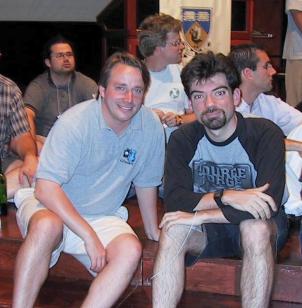Let's start with the dreaded network manager: well, believe it or not, but after 2Y+ of being broken for me, it finally worked. It still had a few rough edges, but it finally would manage my interfaces without crashing.
It still has a few rough edges, and things I had to do were:
It's not perfect but I can now have it seemlessly switch between my wired and wireless networks while keeping the same IP (like I used to do on debian years before networkmanager even existed).
Then comes upstart. It's an overdue parallel init implementation (my cubemate Richard Gooch also wrote one years ago that never caught on unfortunately). It obviously has a few warts: some boots still hang for me, exim isn't supported (booh!), but it should hopefully be fully supported by all soon.
pulseaudio, well, what can I say? It still does not work as shipped. I tried to make it work, but it still randomly hung mplayer and caused other random problems. If it's all this trouble just to get per application volume levels which I can't get in alsa I'm told, and moving audio to other destinations while it's play, which I don't need, it's definitely not worth it for me.
My fix was:
dpkg --purge pulseaudio pulseaudio-esound-compat pulseaudio-module-udev pulseaudio-module-gconf pulseaudio-module-x11.
See this thread on phoronix, this comment sums what I think:
I've never seen such a buggy thing like pulseaudio on linux regular distros.
It's fine people is debugging this stuff, but I think they should not release it till it's stable on 99% of configurations.
Acpid is still kind of broken as shipped for thinkpads, especially if you don't run gnome power manager, which I couldn't find a good reason to run: it's pretty featureless and braindead. Thankfully the acpid author works at my company too and I finally figured out with him that debian killed the logging in acpid, which explains why I couldn't see any output from it anymore when trying to make it work. The good news is that after fixing that I was able to create the right events to support all my Fn keys, and the only thing that really changed in the last years is that I can now call scripts from pm-utils to sleep and hibernate as opposed to doing it all in shell in acpid. Not too bad.
For the rest, it looked like a pretty smooth upgrade: radeonhd still does not work reliably on my Z61p's M56GL [Mobility FireGL V5200] (crashes on 3D, known problem), but radeon still works fine.
